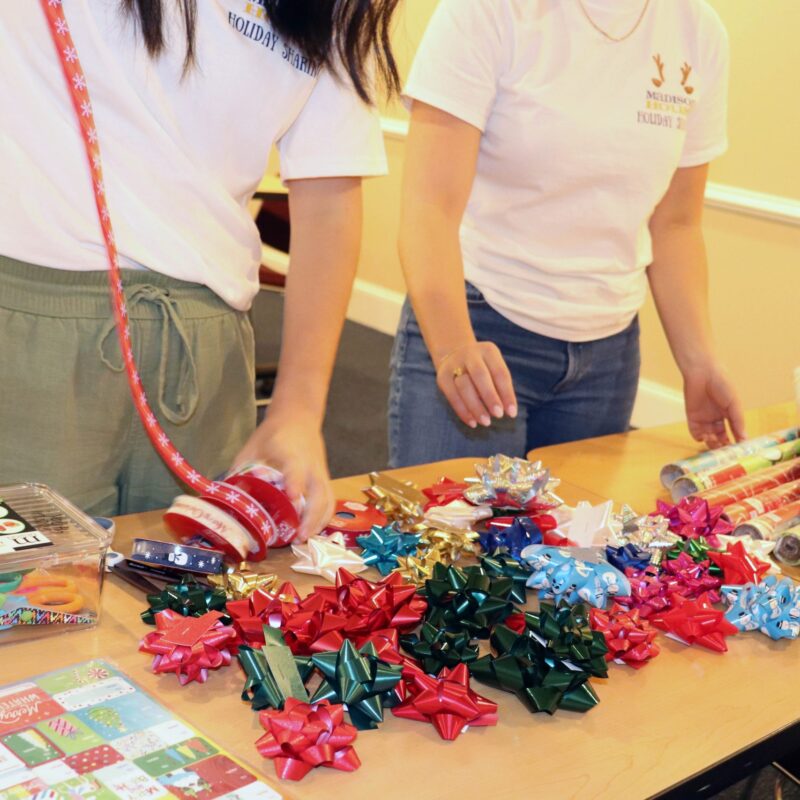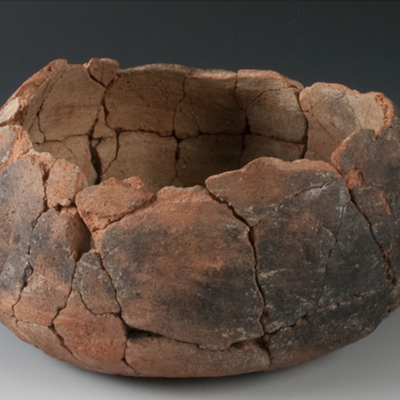Women are everywhere in Charlottesville’s arts community.
Marie Landragin doesn’t just play guitar. She plays guitar like a man. At a recent show at the Twisted Branch Tea Bazaar, her band Corsair thrilled a crowd of about 25 people, mostly men. The focus of the room was not the band’s singer and lead guitarist, Paul Sebring—although he is a compelling and frenetic source of energy, and technically the better guitarist. The focus was on Landragin, going note for note with Sebring in some of the band’s signature moves: Thin Lizzy-inspired guitar duels that lay melody above the band’s virtuosic movements.
It’s fitting that these guitar lines resemble a competition of sorts. Can this chick keep up? But Landragin is almost freakish in her proficiency. Not only does she keep up. She does so in style, playing her guitar as a landscaper handles a weed wacker: with clear command, but far from the face so as to avoid serious injury.
|
As a guitarist for the local metal band Corsair, Marie Landragin is likely Charlottesvile’s most celebrated woman shredder. She first learned to play classical guitar as a teenager, but was drawn to rock music by players like Tony Iommi of Black Sabbath. She first stepped onto the local scene as a guitarist for the annual Mass Sabbath show. |
That Landragin is so eye-catching is testament to a strange aspect of our arts community. Women occupy some of the highest positions of power in Charlottesville arts, and men in bands are open-minded, often sensitive intellectuals who are conversational about issues of gender.
And yet the power women have accumulated at the top has yet to trickle down into the shows at venues around town. At a recent show at Random Row Books, my band played with three others. Over the course of the evening, 14 dudes took the stage and no women. There are also no women in our most famous exports, like Dave Matthews Band and Parachute, nor are there any in many local bands like Invisible Hand or Red Satellites. Men dwarf women on the Red Light Management roster. Of seven shows in the month of May at the Jefferson Theater, only one, Sharon Jones and the Dap Kings, was female-driven. (The ratio is much better in June.)
The rock scene is a visible and surprising stronghold of an old world gender dynamic, where men sop up the glory and women stand on the sidelines—it is, in a way, football-like. So it bears asking. Do they only serve sausage at this barbeque? Where are the women in local rock?
The secret door
Born to an Armenian mother and French father near Melbourne, Australia, Landragin is used to feeling like an outsider. As a kid, she looked different, smelled different. Her friends made fun of the weird food she brought to school. Her family remained in Australia long enough for her to develop the Australian accent that would make her seem even more out of place by the time her father, a winemaker, moved the family to Culpeper, where Landragin started to learn the classical guitar.
In Virginia her friends—skateboarders, art types that they were—gave her cassette tapes of the music that would change her life. There was AC/DC, an Australian band, and some Metallica, which was a little over her head. But it was mostly through listening to Black Sabbath that Landragin learned that she could harness the visceral thrills pioneered by Sabbath’s Iommi. The mid-heavy riffage, the severe bends, the hummingbird hammer-ons.
Since Landragin always stuck out, she says she doesn’t mind being a sore thumb on stage. But women with a more conventional American upbringing learn early to distance themselves from rock music. The process often begins with music lessons. I checked the class offerings at three local music studios to see how many of the listed teachers of rock instruments—guitar, bass and drums, traditionally—were women. Among the dozens of people who teach these instruments at Stacy’s Music, Heinz Musitronics and Richardson Guitar Studio, only one woman was listed: Ann Marie Hohenberger, who teaches beginner’s guitar lessons through Richardson.
|
Kate Howling and Jesse Love graduated from UVA this month. Although they compare their band to others with women in prominent roles, like the Arcade Fire and Broken Social Scene, they say they face a battle against expectations. Everybody thinks they’re going to be bad, says Howling, “And then they see us play.” |
Where only men teach women, problems inevitably arise. Kate Howling graduates this month from UVA, where she joined a band called Pompadour. (The band won UVA’s Battle of the Bands in February, where I was a judge.) As with Landragin, to watch Howling play the drums is to see something of a spectacle. There isn’t the faintest scent of tokenism; she is on stage because she was the best drummer the band could find.
Howling started learning her instrument at the age of 12, and, at the urging of her brother, enrolled in drum lessons. “My drum teacher was always like, ‘Alright, we’re going to learn a Tom Petty song, or an Eagles song,’ and then he’d ask if there were any songs that I wanted to learn. I’d say that I’d really like to learn some Britney Spears.” But, there was to be no learning of Britney Spears songs in the studio. Howling mentioned this story as a kind of a throwaway. But it in fact points to one of the most basic ways that young women are denied opportunities in rock music. A drum teacher, if she happens to be a woman, is likely to be more sympathetic to a younger woman’s interests, even if they include a pop starlet. Most men could care less about Britney Spears—or her music, at least.
There is also the question of buying gear. Haughty gearheads, piles of tiny, useless stuff, bowling shirts that faintly smell of weed—it’s no secret that music stores can be uncomfortable places to visit. Double the discomfort for many women. Carey Sargent plays drums in the local bands Dzian! and the Pinko Communoids, and is a sociologist who has published on the topic of local music stores. “For others with different experiences,” Sargent wrote in a 2006 paper, “such as playing privately, knowing more about hip-hop than rock, or having classical training on the guitar rather than immersion in the rock music practice, the experience can be a struggle to comprehend the language and interactions of the environment. Finding themselves in this position, these musicians may defer to others to perform, speak and choose in their place.”
|
Wendy Hsu and Carey Sargent are both pursuing graduate degrees while maintaining an imposing presence in the local music community with their groups the Pinko Communoids and Dzian!. |
Landragin’s experience as a young player bears testament to Sargent’s research. Landragin says that she “never, hardly ever” sees women in local music stores. As a classical guitar player, she slipped inconspicuously into music stores to buy nylon strings.
Music store employees “started getting interested and asking about my playing” when she started buying steel strings for her electric guitar. “I never started playing guitars in music stores,” Landragin adds, “until I got the balls to realize that it didn’t matter.”
The experience in music stores also plays out in the actual playing of rock and roll. Jessie Love, also of Pompadour, shakes a tambourine onstage and trades off vocal lines with primary songwriter Jeff Doyle. A French horn player by training, she studied music and performed with a university orchestra for the first two years of college. By the third year she was burnt out on classical performance and was drawn to the casual catharsis of rock music. She joined Pompadour when she heard Howling, her roommate at the time, practicing in the basement with Doyle. Like Howling, Love too made a throwaway comment that, to me, spoke volumes: “We tried to incorporate French horn into Pompadour,” she laughed, “but there wasn’t any room for it.”
Wendy Hsu is the driving force behind Dzian!, a band she shares with Sargent and that plays covers of Taiwanese and Japanese garage rock songs. Like Love, she was classically trained in the viola and the piano. The first band she ever joined was a ska band, which incorporates complex horn arrangements into rock and reggae. She left the band after a year and a half. “It felt like they didn’t want me there,” she says. “They attributed our differences to a difference in style—not playing not being ska enough, but too classical.”
Think different
Most local rock shows are booked by men. Andy Gems runs the Southern, Danny Shea books the Jefferson Theater, and Jacob Wolf and Jeyon Falsini book independently around town, at places like R2 and the Twisted Branch Tea Bazaar. Asked how often he books bands with women in them, Falsini says, “Not all that often.”
But it’s not for the lack of trying. “It adds a nice dynamic to the bill, or to the act,” he says, “when there’s a woman involved. Women think different, sound different, they look different.”
Gene Osborn, frontman and songwriter for We Are Star Children echoes this sentiment. Osborn says he started the band—until recently, they were called Straight Punch to the Crotch—with two women among the original members. Since then the band has maintained a roughly even ratio of men and women. (The three women who are permanent members of the band are trumpeter and vocalist Aly Buchanan as well as new backing vocalists Mary Butcher and Jeannette Williams.) Osborn says that he’s worked to maintain that ratio. “I think music in many ways represents life, and the structure of community, and when you look at a performance and there’s a mix of men and women in synergy, it just adds energy to the music, to the stage show.”
“Bands are about people coming together,” he adds, “with a common vision and I just find that that vision is strengthened when it’s shared between women and men.”
But men and women have rarely shared such a vision throughout history. Hsu is pursuing a graduate degree in ethnomusicology. She says there are many ways to trace the course of rock history vis-a-vis chicks. “Obviously,” Hsu says, “it’s occurred throughout history, where women are not associated with being in public spaces, where women are associated with passivity and quietness. All of these larger cultural values come into play when were talking about rock music.”
One transformative moment, she says, in that history is when “rock and roll”—a form for excited teens in dance halls—became simply “rock.” That happened when these teens grew up, and wanted something more art-related. “It became rock, which was oppositional to pop music. Pop music was more commercialized, more superficial, and more associated with women.” The sheen of pop and the rigidity of classical music took on feminine associations, and none of them fit the rock bill.
Sarah White, who has spent the last year working with a new band that consists of men, says, “Of course for any rock musician, performing is all about posturing for sex.” The upshot of this historical trend is that women often didn’t have women musicians to look up to in the rock tradition. (There are, of course, some notable exceptions, from Janis Joplin to Patti Smith.) Landragin says the music of Black Sabbath and Metallica hooked her more than what women were doing in the ‘90s. “I thought the women in rock, the ones that were there, were really kind of cheesy.”
Sargent says she was driven to learn to play drums at the age of 12 by listening to her fathers’ records, where she first heard the bombastic sound of the greats, Mitch Mitchell from the Jimi Hendrix Experience and Ginger Baker from Cream. (Don’t be fooled. Ginger is a dude.) She says that she deliberately avoided listening to music made by women. “I was sort of a misogynist when I was little, and I thought I didn’t want to listen to any women musicians. That comes from the culture, that women musicians are quasi-musicians, but they’re mainly there for their looks.”
One of the guys
On stage, some women don’t consider what others think of them. Others are consumed by it. One doesn’t even identify as a woman. The one thing they agreed on was that when they perform rock music in town, they feel they’re regarded as women musicians, as opposed to musicians who happen to be women, or simply musicians.
Melissa Goode is the music director for WNRN, a woman who has survived and thrived in the music industry. At a recent music festival in Harrisonburg she participated in a panel on women in the music industry alongside a musician from Richmond and the owner of a record label—both women. Goode reached the same conclusion that she often does in interviewing women musicians on the air: “We were all sort of one of the guys.”
“When I was first starting out,” Goode says, “there was a lot of me asking that question: ‘Is it hard to be a woman in the music industry?’ I actually asked that question in interviews a few times. But women are like, ‘I’m in a band, I get up and I sing in front of people. They either really like me or they really don’t. That’s what I do, and that’s what I want to do.’”
But women who join bands are often called upon to make concessions, subjugating their emotional comfort to their desire to be in a band. The women of Pompadour mentioned a time when they refused to play a song with sexual themes, strongly phrased, that made them uncomfortable. Sargent too, as a member of a local band called the Fountainhead, was one woman among three men. (One unfavorable review referred to the band as “four inoffensive looking dudes.”) “I had to be a girl they respected,” says Sargent, “like they respect their sister, or I had to be someone they could sleep with. Or I had to be a guy. There was no other space for me. So they were like, ‘You’re our Mom.’ I didn’t want to be their mom.”
The culture did not stop in the band. One day, Sargent heard through the grapevine that one of her favorite music professors stepped into territory that most college professors know to avoid: “I can always tell when I hear a woman drummer,” he said. So Sargent showed up at the professor’s office door and confronted him. What was he trying to say: that women can’t drum as well as men? The professor explained. The drums are a physical instrument that require players use a wide range of motion.
Women, however, are socialized to take up small amounts of space, so they often don’t use the range of motion a drummer needs to hit drums dead on. The result is that women drummers tend to play more softly than their male counterparts, and hit the drums closer to, and often on, the the rims.
Whether there are real differences in the way each gender plays, women have to battle the expectations that, because they’re women, they’re going to play differently. (Different often means worse.) I spoke with Kim Dylla, the lead singer of Thismeansyou. Many of the band’s press photos feature Dylla in a bikini-like top, standing before four dudes, each looking mean and dressed in shades of black. When I asked Dylla what kind of music her band plays—Goth? Industrial?—she clarified, “Metal.” “I always like metal a lot,” Dylla says.
|
Ten years after Kim Dylla joined the metal band Thismeansyou, she says that people still ask her when she enters a club whether she is a groupie, or one of the other members’ girlfriend. |
“And I used to scream along to death metal in the car. And then my friend, who sings in In Tenebris,” the local metallurgists who broke up last year, “said that these guys were jamming at their practice spot, and they wanted a girl who could scream. So I came down and I screamed into the microphone. I was about a 95-pound female at the time, and I think they stopped playing, and said, ‘You’re hired.’”
“A lot of what makes our band our band, is that I’m a girl—not that it’s a gimmick, or a token or anything. But it sets us apart.” Almost a decade after joining the band, when Dylla shows up to play shows, she says that venue staff often mistake her for the girlfriend of one of the male band members, or a groupie. “And then during sound check I scream and they’re like, ‘Oh my God. That sound comes out of you?’” The lack of familiarity may, in part, have to do with what she calls a lack of venues that are accessible to metal bands here—the recent closure of the Outback Lodge has spelled trouble for many of the heavier acts.
This might be less true of genres like folk and country, which have a more visible tradition of strong women in leading roles. At recent shows, White has transitioned to fare that rocks in its own right, but doesn’t reach the in-the-red fury of metal shows. Whether she’s playing selections that are more folk- or rock-influenced, White says, “I feel quite comfortable on stage playing either.” In her band, she says, “As musicians we are equals. There are no gender-based power dynamics. If one of them had a problem with me having breasts, they probably wouldn’t be there.”
But in some genres, having breasts is a fundamental problem. Dylla has started recording material that branches out into black metal territory, a more dirgeful and intense take of the metal genre. It’s also, she says, “highly ideological.
|
How does being feminine play into her music? “I don’t think of my creative self in a category: a gender, an other, an outsider, an insider, or anything like that,” says Sarah White, who these days has an all-male rock band backing her up. |
“I always wanted to be in a black metal band, but nobody ever wanted to let me do vocals for them.” Dylla says there’s not much of a market for black metal in Charlottesville, but the market that does exist is cult-like and male dominated to the point where she says it’s impossible to attract even a boutique label if a woman so much as touched a black metal record. Like Mary Ann Evans, who, under the pen name George Eliot, became one of the leading writers of the Victorian era, Dylla says that she may have to adopt an anonymous persona to release her black metal opus.
Gender also influences Hsu and Sargent’s playing in more concrete ways. Sargent is less concerned with whether her performances as a drummer will be construed as representative of what her gender is capable of—less concerned that each missed note will ring a weak and ugly chord struck in the name of all women. While playing covers, Sargent says the band deliberately tries to incorporate the errors of the original version into live performance. A similar line of thought informs Sargent and Hsu’s other band, the Pinko Communoids, perhaps the world’s softest noise rock band. If women don’t utilize the range of motion to play drums correctly, Sargent’s performances in that band are a sort of parody of gender expectations—deliberately hitting the rims, dropping drum-sticks to see what sound they make.
I asked White how her concept of femininity plays into her music. She says, “I don’t think of my creative self in a category: a gender, an other, an outsider, an insider, or anything like that. So the question befuddles me.” She instead passed the question on to Michael Bishop, a man and former member of the band GWAR who now plays with White. He replied in an e-mail.
“Your music isn’t gushing, and it’s not full of false quasi-feminist pride and postured ‘strength.’ You take all that for granted,” Bishop writes of White’s music. “In other words, I hear aching and self-doubt, ambivalence, playful arrogance, honest struggles with selfhood, the desire to be empowered and creative and loved, I hear that in the music, but no more than I hear when having a conversation with you.










